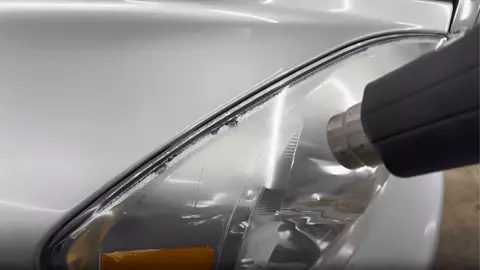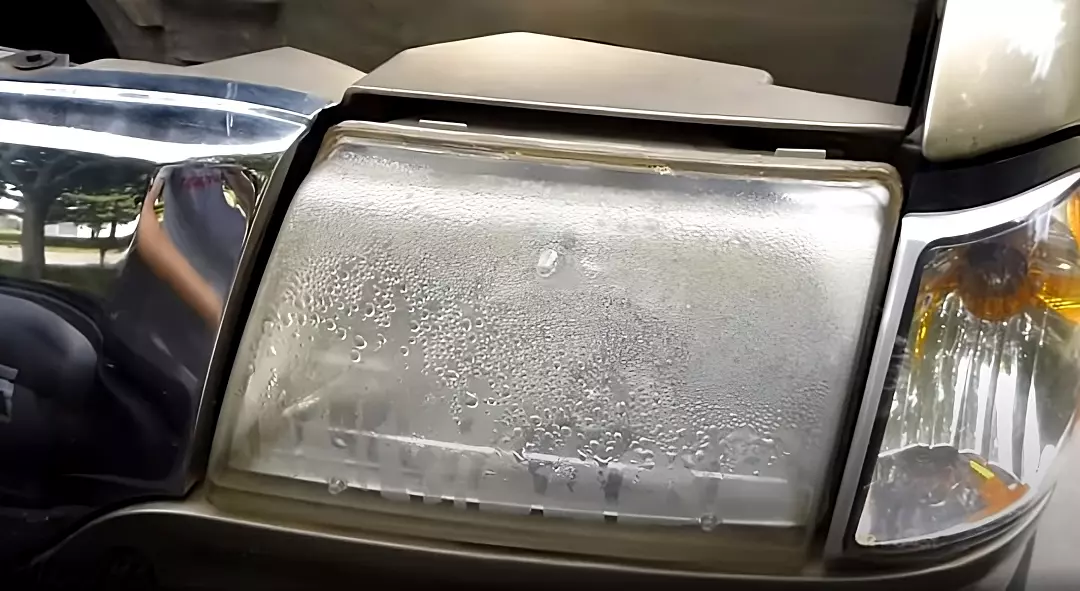While driving in high-humidity locations, car owners struggle to keep the headlights clean. They frequently notice condensation develops over time as moisture draws from the air via ventilated holes and gradually accumulates inside the car headlight. And ultimately, foggy light affects nighttime seeing or breaks the bulbs. Then, what should we do or how to remove moisture from the headlight?
Prevent moisture using the hairdryer, pressurized air, vacuum cleaner, silica gel packaging, or fixed seal to prevent dampness from getting inside the headlight. Additionally, sealing, changing the gasket, fixing drainage arrangements, or using a resistant cover will reduce the chances of moisture buildup.
If your vehicle light looks disturbing with fog, following our tips will help to prevent growing moisture inside. So, let’s dig deeper to understand how you should deal with headlight fog.
Why Does My Headlight Have Moisture In It?

In general, temperature changes cause moisture or fogginess inside the vehicle headlight, like how the windshield gets moisture whenever we turn on the AC.
Moisture can build up inside your car’s headlight due to numerous reasons. Less water or moisture can be acceptable, but your headlight or lightbulb may get damaged if the amount is excessive. But what causes moisture in headlights? A few facts will clear your mind!
- If the interior of the lens is cooler than the surface, moisture gathers inside and causes condensation in the headlight.
- You might notice that the air inside your headlight unit is cooling more rapidly than the outside lens.
- Your headlight inside becomes moist whenever it gets damaged or cracked.
- Water splashes onto the outer side of the glass, or moisture may go inside through any holes.
- Sealed stream for headlight with filament and reflector can become faulty seals or bulbs and develop excessive moisture inside the headlight at night.
- Moisture can build up inside your headlight due to obstacles such as dirt, dust, insects, spider webs, or other buildups in your headlight housing vent.
Is Moisture In Headlights Normal?
It’s completely normal to have condensation on the surface of the car’s lenses or moisture buildup inside the headlights since there are no airtight seals. And whenever it’s sunny outside or the temperatures increase, the lights dry out quickly within a few minutes.
However, observing excessive moisture may block the headlight from shining clearly. Such dampness also impacts the bulb filament, which is susceptible to burning out at any moment.
How Does Moisture Affect Your Headlights?
We found no problems in the car’s performance or while operating with moisture buildup. The development of moisture on headlights can be okay until you notice too much of it.
Condensation results from the exterior lens cooling faster than the air inside the headlight assembly. Where headlamp vents let extra heat and moisture escape. But wetness or fog may impact due to some facts such as:
- Excessive moisture inside the seal may dim the light or develop a blind spot.
- Trapped headlights with fog make your nighttime driving, as well as low light conditions, which is risky while you ride.
- If the seals fail to let the moisture out properly, too much moisture can trigger your car’s electrical components.
- Some states even restrict the use of foggy headlights during car checks.
Will Headlight Moisture Go Away?
Of course, moisture will disappear if the temperature stays stable or balanced. Naturally, the moisture will dry out after a few minutes with lights on or in sunny weather; if it won’t, wait for 2 or 3 weeks to dry as moisture will go based on the weather.
However, you can keep the headlights secured from fog, whether minor, moderate, or major condensation since we have some magical tips waiting below.
How To Remove Moisture From Headlight: 7 Tips To Get Crystal Clear Headlights

Generally, car headlights come in two water intake levels: A little and a heavy water intake. Based on the moisture level, we have some solutions for restoring the light’s crystal-clear brightness.
The next section will let you explore how to remove moisture from a car headlight without opening, plus how you remove moisture from the inside of headlights. If it is about little water intake, the hair dryer, desiccant gel, vacuum cleaner, or environment will remove the moisture.
And for heavy moisture issues, take off the cover and clean it. Simple! Now, let’s talk about removing the fogginess in the headlight.
1. Natural Release of Moisture:
A little moisture buildup can usually be escaped on its own. Since the seal is not that tight, plus there is a bulb inside, the light heat will absorb the moisture quickly. The sun or warm temperatures can also help allow moisture in the headlight to evaporate. However, bear in mind that LED light does not help absorb moisture.
2. Desiccant Or Silica Gel Packet:
Silica gel or other desiccant packets can temporarily remove dampness by placing them inside the headlight housing. If drying out headlamps becomes more challenging, fill them with silica gel and wait at least one day or 24 hours to dry.
3. Hair Dryer:
As an alternative to silica gel, a hair dryer or heat gun can do your job to remove minor condensation! Start the hair dryer for a few minutes and hold it near the headlight. The heat will absorb the moisture, but choose a low setting over a high one that may overheat the headlight area and burn things.
4. Pressurized Air:
Pressurized air can dry out fog for the moderate level of cloudy moisture buildup inside the vehicle headlight. So, press the button to discharge the air and point the can at the lens. While doing so, keep the can 12″ far from the headlight.
5. Vacuum Cleaner:
We advise removing wetness from the headlight using the Vaccum cleaner’s nozzle. It will work as a foggy headlights cleaner.
6. Fix the Seals:
A headlight seal keeps the outside elements and moisture from entering. But over time, it might break or crack. As a result, you can add a new heat and water-resistant sealer. You may need to resolve the water vapor or moisture trouble by removing the seal on your headlamp. However, it’s recommended to take advice or help from a mechanic.
7. Opening The Headlight:
Suppose you have noticed water in the headlight after rain that developed excessive condensation. Since this is a serious issue, you must open the headlight to repair it. Let’s look at the steps to dry the headlamps after moisture exposure.
- First, remove the screws positioned along the lens cover’s edge.
- You may notice a light bulb, wires, and a metal retained ring holder by removing the cover.
- After that, remove the bulb by turning the retaining ring counterclockwise.
- Then, use a soft cloth to wipe away the interior moisture.
- If you notice any remaining moisture, use the silica gel packet.
- And while ending up wiping moisture, put the headlight back and screw the lens cover properly.
Some Additional Tips To Remove Moisture In Headlight New Car
We already mentioned the best ideas to remove little from excessive wetness or fog from the headlight. Besides that, people often try some alternatives that we like to present.
- Different on or off-light cycles will help remove moisture from the headlight.
- Shield with a waterproof cover while parking the car.
- Ensure the drainage system is functioning well.
- Cornstarch is effective in absorbing any moisture.
- A 3/4 cup silica gel with 2 cups white vinegar heated to around 120 degrees Fahrenheit will eliminate cloudy moisture.
- Positioning the car’s front side close to the dehumidifier for a day will dry out water or moisture.
Prevent Further Moisture From Building Up
As a car owner, you should clean the moisture from the headlight and decide how to stop further fog buildup. So, here are some tips for you!
- Check the car frequently for leaks or any indication of dampness.
- Ensure the seals are not defective or broken.
- Keep a dry environment to avoid any moisture accumulation.
- Parking a car in a garage will be preferable.
- Shut the windows on rainy or wet days.
- Please turn on the AC in winter, as it works like a dehumidifier.
- A moisture absorber can also ensure a dry headlight.
Frequently Asked Questions
How do professionals clean headlights?
Professional headlight cleaners clean the headlight by following the cheap way to clean headlights, such as:
1. A headlight restore kit.
2. Use baking soda and toothpaste.
3. Apply sandpaper to clean the lens’s deteriorated coating from its surface.
4. Wash the headlamps and let them dry out.
5. For moisture, they use a silica gel packet, hair drier, or vacuum cleaner or change the broken seals if required.
How to remove moisture from BMW headlight?
Whether it’s BMW or any other car, moisture or condensation can be released by a hair dryer by heating low heat setting, with pressurized air, by placing silica gel packets, or by following steps such as:
1. Cleaning the headlight by taking the cover off.
2. Wipe it with a dry cloth to ensure the light is moisture free.
Can you clean the inside of the headlight lens?
You can uncover the vehicle headlight to clean the inside of the lens. However, follow the instructions for a perfectly clean headlight once more.
1. Put hot water in a container.
2. Remove the built-up grime or moisture from your headlights by adding some detergent to the water.
3. The abrasive pad may require hot water.
4. Wipe any dirt or moisture buildup in headlight lenses by using a pad.
5. The interior of your car’s light can be cleaned using the magnet cleaning tool.
What liquid cleans foggy headlights?
The best cleaner for cleaning foggy headlights combines baking soda and toothpaste. They will remove the fog or moisture without causing any damage. A vinegar and baking soda combination can also be a good DIY solution. Plus, we occasionally observed individuals using paper towels and polishing compounds.
How do you remove heavy oxidation from headlights?
The combination of toothpaste and baking soda or toothpaste and vinegar works like magic to remove heavy oxidation. It’s because the mixture includes a tiny amount of abrasive materials that remove grime, road particles, and the effect of oxidation.
Final Words
Next time, if you find any trouble in the headlight due to moisture accumulation, you won’t have to ask how to remove moisture from the headlight. We’ve guided you with the easiest DIY solutions, particularly keeping silica gel, using a hair dryer, and using vacuum cleaners to remove buildup fogs inside the headlamp. An excessively gloomy or dark headlight with moisture requires fixing the seal by opening the headlights.
On the other hand, our suggestions to stop further moisture buildup should be followed. And keep your eyes on the car’s headlight to notify yourself when to clean the moisture and when to leave it to dry out naturally.

Hello there, this is Thomas Byrd. I am a professional car mechanic who leads a team of junior mechanics in a repair and restoration shop. In the beginning, I used to work for a jeep service center as a basic worker. From there I keep learning, changed my job 2 times and now I am a professional who leads a group of mechanics. Though a have expertise in the jeep, I know very well about all types of cars. To share my knowledge and skills with others I have created this blog website. Whenever I get free time from work I give my time to my blog.

